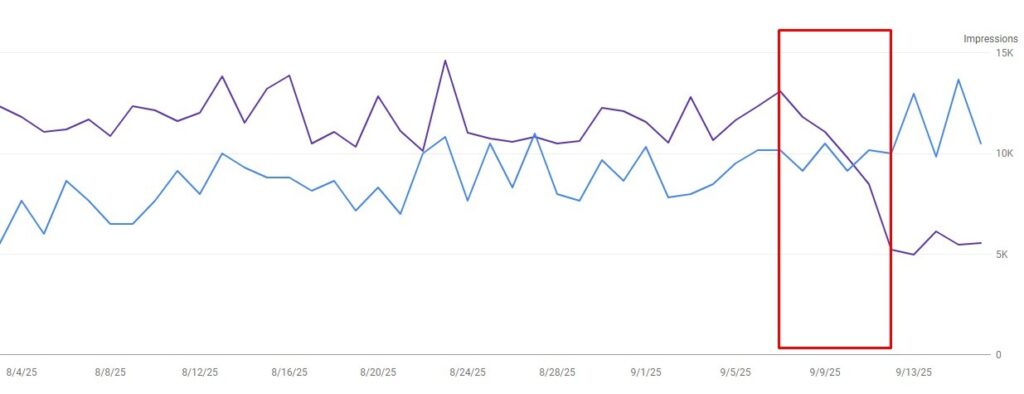If your September SEO rank report left you puzzled, take a breath. Google’s latest change affects how we track, not how we actually rank.
In mid-September 2025, Google disabled the ‘&num=100’ URL parameter that many rank-tracking tools relied on to fetch 100 results at once. This was an intentional system change by Google rather than a bug. As a result, rankings beyond page one look unreliable in many tools, and rank tracking providers are still figuring out long-term solutions.
At the same time, a noticeable drop in desktop impressions has shown up in Google Search Console reports. The leading theory is that bots loading 100-result pages used to inflate impressions, and with the parameter removed, those artificial impressions have dropped. Google hasn’t officially explained this side effect, but it’s something to keep in mind when reading your reports.
What changed?
1) The SEO community noticed Google stopped supporting the ‘&num=100’ parameter around September 10. On September 18, Google confirmed it does not support a results-per-page parameter, making it clear the change was deliberate.
2) Without ‘&num=100’, tools need to load multiple paginated results to capture positions beyond the top 10, which increases resource costs and introduces gaps. Some providers have already reduced how deeply they track results by default.

3) Many sites saw impressions fall and average position improve from about September 10 onward. The most widely supported theory is that bots loading 100-result pages used to generate impressions that counted in GSC. Now that Google no longer supports that parameter, those bot-driven impressions have been reduced.

What this means:
- If impressions are down but clicks and conversions are steady, there’s no cause for alarm.
- GSC remains highly useful, but the impression line is less comparable to historical periods before this change.
In practice, it means reports from rank trackers look jumpier after page one, and Search Console impression numbers need a careful read.
How is SearchMax preparing for this?
1) For rankings beyond page one, we’re supplementing tracker reports with Google Search Console data and manual rank checks for important search queries.
2) Reports will continue to prioritise page-one performance, traffic, and conversions rather than deep-rank fluctuations.
3) We’ll mark mid-September 2025 in monthly reporting so comparisons across this date aren’t misread.
4) We’re keeping track of updates from Google and rank-tracking providers to adapt our reporting approach as new solutions roll out.
What does this mean for you?
1) Short term, ranking data after page one will be thinner or more volatile. Don’t be surprised if deep-rank positions look unusual in future reports.
2) If impressions dip but clicks hold steady, the change is likely due to fewer bots, not fewer real users.
3) Comparisons with impressions data before September 2025 should be treated with caution, since the reporting environment changed. And, when judging performance, lean more on page-one rankings, traffic and conversions.
For now, this is less about real-world SEO shifts and more about how Google’s system changes ripple through third-party tools and reporting. We’ll keep monitoring the situation and update you as more information becomes available.

Written by Kanesh
Kanesh is an SEO strategist who helps brands turn search visibility into measurable business growth. He approaches SEO with a data-driven mindset by testing, analysing, and refining strategies to build momentum that lasts. His work combines technical SEO, content strategy, and data insights to improve visibility where it matters most. Passionate about how search is evolving, he helps brands stay ahead as algorithms, AI, and user behaviour continue to shift.
Share

Written by Kanesh
Kanesh is an SEO strategist who helps brands turn search visibility into measurable business growth.



